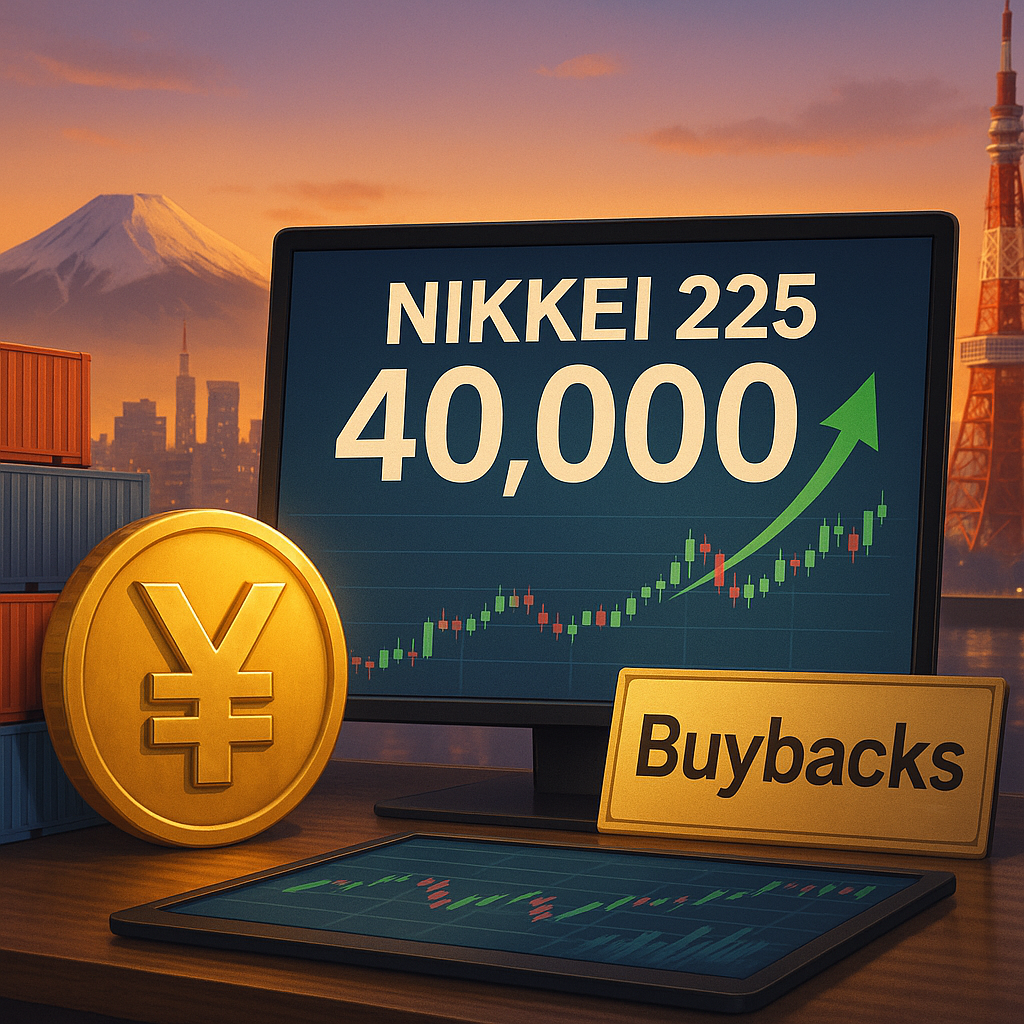A weaker yen, record corporate buybacks, and firm overseas demand have combined to send the Nikkei 225 through the psychologically important 40 000 mark for the first time ever. The surge, dubbed the Nikkei 225 export boom, has revived global interest in Japanese equities. It has also prompted investors to ask a simple question: how long can the good times last?

Nikkei 225 export boom – Why a Cheap Yen Still Matters
Japan’s currency has fallen more than 12 % against the U.S. dollar since last summer, trading near ¥154 per dollar in mid-June. A softer yen juices exporters’ overseas revenue once profits are repatriated. It also makes Japanese goods cheaper abroad. Roughly 46 % of Nikkei 225 sales come from foreign markets. That share rises above 70 % for heavyweights such as Toyota, Sony, and Hitachi. The latest earnings season confirmed the tail-wind. Aggregate operating income for index constituents rose 18 % year-on-year. It beat analyst expectations by the widest margin in eight quarters. This earnings surprise, paired with dovish signals from the Bank of Japan, set the stage for the Nikkei 225 export boom to accelerate into early summer.
Nikkei 225 export boom – Buybacks Add Fuel to the Rally
Currency weakness alone does not explain the index’s sprint through 40 k. Japanese firms have also embraced share repurchases at a record pace. They announced ¥9.3 trillion in buybacks in the fiscal year that ended March 2025—up 27 % from the prior year. Sony, SoftBank, and Mitsubishi each unveiled multi-trillion-yen programs. Meanwhile, smaller manufacturers followed suit to appease activist investors and close valuation gaps. These buybacks reduce free-float supply and mechanically lift earnings per share. Thus giving the Nikkei 225 export boom extra thrust. Importantly, Japan’s new corporate-governance code pressures boards to improve capital efficiency. So the buyback trend appears structural rather than cyclical.
Earnings Windfall but Rising Risks
Exporters now enjoy windfall margins, yet several factors could compress profits. First, commodity costs are climbing: crude oil trades above $85 per barrel, and copper sits near decade highs. Higher input prices can erode the benefit of a weak yen. Second, global demand might cool. Although U.S. growth remains solid, Europe teeters close to recession. Meanwhile, China’s recovery is patchy at best. If global orders fade, factories from Nagoya to Kyushu will feel the pinch. Third, the Bank of Japan will not keep policy loose forever. Governor Ueda hinted that wage growth above 3 % could warrant another rate hike by year-end. A modest shift in short-term rates would reduce the yen carry trade. This could lift the currency by 5 %–7 %, shaving export earnings in the process.
Positioning for the Nikkei 225 export boom
Active managers favour companies that capture the yen tail-wind but also hold pricing power if costs rise. Toyota trades at 11 × forward earnings and sports a net-cash balance sheet. Every ¥1 move in the yen adds roughly ¥45 billion to operating profit. Semiconductor-equipment supplier Tokyo Electron commands a richer multiple. However, AI-linked demand and a 3 % dividend yield make it a core holding. On the mid-cap side, robotics specialist Fanuc and machine-tool maker DMG Mori stand out. Both derive over 70 % of sales offshore and benefit from industrial automation trends. Investors can hedge against a potential yen rebound by pairing longs in exporters with shorts in domestic utilities. These tend to suffer from weaker currencies due to imported fuel costs.
Historical Perspective and Valuation
The Nikkei last hit a major milestone—30 000—in February 2021, only to retreat 15 % as the global tech correction unfolded. Today’s climb appears sturdier. Price-to-book for the index is 1.6 ×, still below the S&P 500’s 4.2 × and Europe’s 2.0 ×. Return on equity has doubled in a decade, reaching 10.4 %. These metrics suggest room for multiple expansion if governance reforms stick. Yet there are caution lights. The index now trades at 20.5 × forward earnings, above its ten-year average of 17 ×. Therefore, further gains depend on continued profit growth or a sustained currency tail-wind.
How Long Can Japan’s Export Boom Last?
Timing turns is tough, but current drivers look durable into 2026:
- The Federal Reserve may cut rates twice, widening the U.S.–Japan yield gap and keeping the yen weak.
- Buybacks should remain robust, as Tokyo Stock Exchange pressure makes under-performing boards act.
- Structural demand for automation, electrification, and AI chips supports capital-goods exporters.
Offsetting forces include a sharper-than-expected rebound in the yen if global risk appetite falls or if the Bank of Japan tightens faster. Energy-price spikes and geopolitical shocks in Asia could disrupt supply chains. Finally, protectionist trade policies—particularly in electric vehicles—may cap export gains.
For now, the Nikkei 225 export boom shows few cracks. Domestic wage increases, modest inflation, and stronger household spending are poised to add a second engine to Japan’s growth story. Investors who missed the initial move still find opportunities in mid-cap industrials and overlooked tech names, provided they watch the currency and policy signals closely. History teaches that Japan’s rallies can last longer than sceptics expect. Yet they fade quickly when the yen strengthens. Monitoring the yen’s trajectory, buyback announcements, and global PMI data will help gauge when the export boom shifts from tail-wind to head-wind.